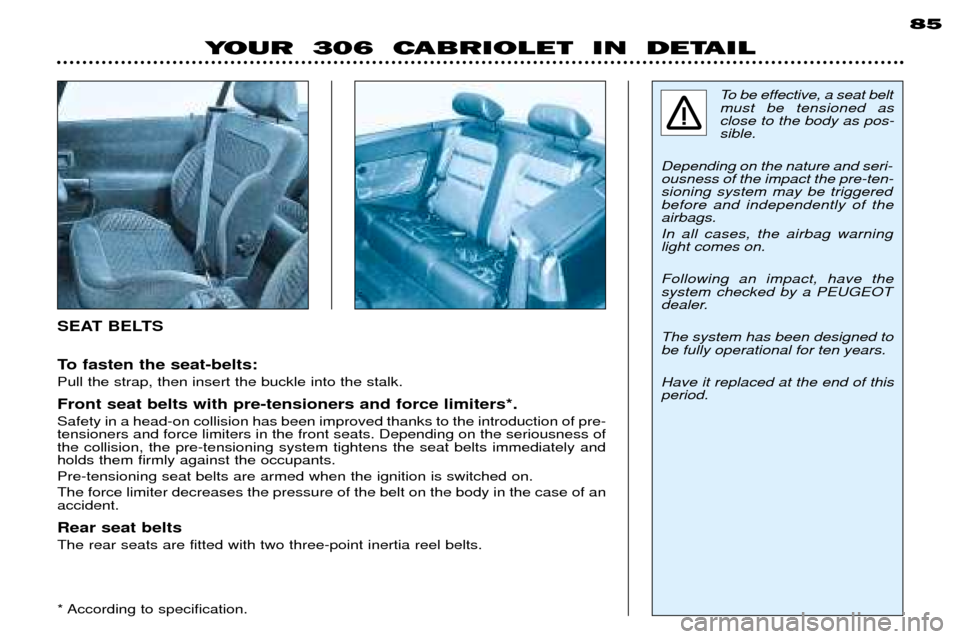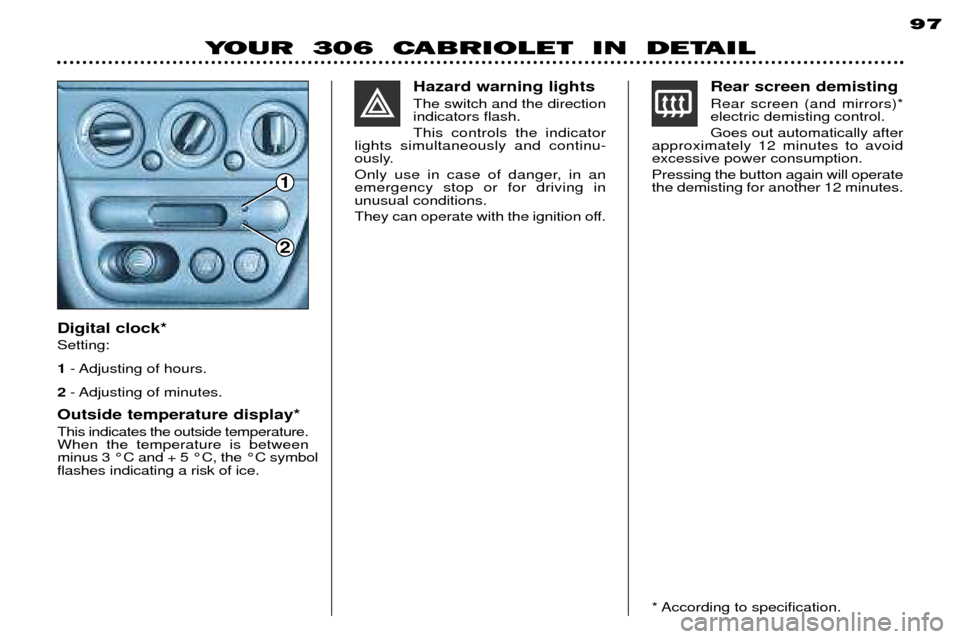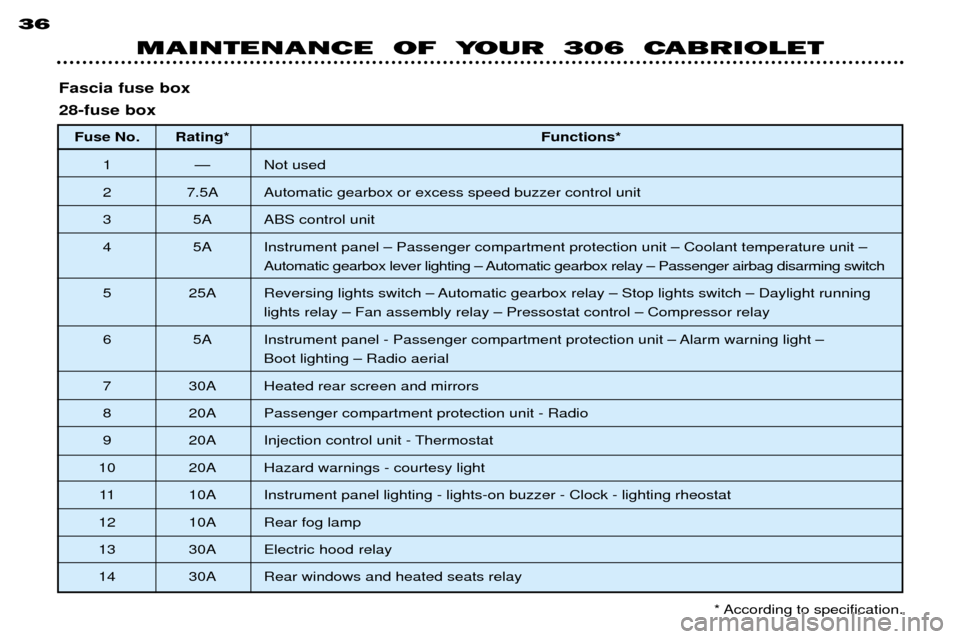warning light Peugeot 306 C 2001 User Guide
[x] Cancel search | Manufacturer: PEUGEOT, Model Year: 2001, Model line: 306 C, Model: Peugeot 306 C 2001Pages: 133, PDF Size: 2.08 MB
Page 66 of 133

To fasten the seat-belts: Pull the strap, then insert the buckle into the stalk. Front seat belts with pre-tensioners and force limiters*. Safety in a head-on collision has been improved thanks to the introduction of pre- tensioners and force limiters in the front seats. Depending on the seriousness ofthe collision, the pre-tensioning system tightens the seat belts immediately andholds them firmly against the occupants. Pre-tensioning seat belts are armed when the ignition is switched on.The force limiter decreases the pressure of the belt on the body in the case of an accident. Rear seat belts The rear seats are fitted with two three-point inertia reel belts.
* According to specification.To be effective, a seat belt must be tensioned asclose to the body as pos-sible.
Depending on the nature and seri-ousness of the impact the pre-ten-sioning system may be triggeredbefore and independently of theairbags. In all cases, the airbag warning light comes on. Following an impact, have the system checked by a PEUGEOT
dealer. The system has been designed to be fully operational for ten years. Have it replaced at the end of this period. 85
YOUR 306 CABRIOLET IN DETAIL
SEAT BELTS
Page 75 of 133

YOUR 306 CABRIOLET IN DETAIL 97
Rear screen demisting Rear screen (and mirrors)* electric demisting control. Goes out automatically after
approximately 12 minutes to avoid excessive power consumption. Pressing the button again will operate the demisting for another 12 minutes.
* According to specification.
Digital clock* Setting: 1
- Adjusting of hours.
2 - Adjusting of minutes.
Outside temperature display* This indicates the outside temperature. When the temperature is betweenminus 3 ¡C and + 5 ¡C, the ¡C symbolflashes indicating a risk of ice.
1
2 Hazard warning lights The switch and the direction indicators flash. This controls the indicator
lights simultaneously and continu-
ously.
Only use in case of danger, in an emergency stop or for driving inunusual conditions.
They can operate with the ignition off.
Page 82 of 133

103
DRIVING YOUR 306 CABRIOLET
AIRBAGS* The airbag system has been designed to maximise the safety ofthe occupants in the event of seriouscollisions. It works in conjunction withthe seat belts. The electronic detectors register and analyse any abrupt deceleration of thevehicle; if the triggering threshold isreached the airbags inflate instantlyand come between the occupants andthe vehicle. Immediately after the impact, the
airbags deflate rapidly, so that they donot hinder the visibility of the occu-pants and their exit if necessary fromthe vehicle. The airbags are not deployed in the case of collisions which are notserious, for which the seat belt is suf-ficient to ensure maximum protection.The seriousness of a collisiondepends on the nature of the obstacleand the speed of the vehicle at themoment of the collision. Airbags only operate when the ignition is switched on. Note:the gas escaping from the
airbags can be a minor irritant. FRONT AIRBAGS These are folded in the centre of the steering wheel for the driver and in
the fascia for the front passenger.They are deployed simultaneously(except in cases where the airbag isdisarmed), for frontal impacts wherethere is a risk of injury to the head orchest.
DISARMING THE
PASSENGER AIRBAG
To ensure the safety of your child, it is essential to disarm the pas-senger airbag when you install arearwards-facing child seat on thefront passenger seat.
Remove the ignition key, insert it into the passenger airbag switch
1and
turn it to the Ò OFFÓ position.
Ð The airbag warning light on the instrument panel is lit throughoutthe disarming process.
In the ÒOFFÓ position, the passenger
airbag will not be triggered in theevent of an impact.
Page 93 of 133

YOUR 306 CABRIOLET AT A GLANCE9
9
FUEL FILLER FLAP
To open: firmly pull the handle on the floor to the outside of the drivers seat.
To close: from outside, push the flap back and check that it is secured
correctly. Filling with fuel Switch off the engine. There is a holder for the fuel filler cap.
A label on the inside of the flap shows which fuels are permitted and which are not allowed.
The capacity of the tank is approximately 11 gallons (50 litres).
Fuel low warning light The fuel low warning light indicates that the quantity of fuel remaining in the tank is approximately 1.3 gallons (6 litres).
81
Outside the vehicle Raise the catch 1and
support the bonnet as it rises.
OPENING THE BONNET Inside the vehicle:
Pull the
handle.
88
1
Page 115 of 133

MAINTENANCE OF YOUR 306 CABRIOLET
32
Dipped/main beam headlamps Double headlamps: two H7 55W bulbs. Changing the bulbs
Turn the plastic protector and remove it. Disconnect the connectors.Press the spring to unclip the bulb and then change it. When fitting, ensure that the direction notches are positioned correctly andthat the plastic protector is secured
correctly. Only handle the bulb using a dry cloth. Warning There is a risk of damage to the dipped/main beam headlamps. Only use bulbs supplied by the following manufacturers: - GE/TUNGSRAM- PHILIPS- OSRAM
These bulbs meet the UV-free speci- fications necessary for the correctoperation and reliability of the head-lamps. The headlamps are fitted with poly- carbon glass with a protective coating.
We strongly advise against cleaningthem using a dry or abrasive cloth orusing products which contain deter-gents or solvents.
ATTENTION
VOIR NOTICE
WARNING READ
INSTRUCTIONS
H7 UV
CHANGING A BULB
Side lights W5W
Turn the plastic protector and remove it.
Turn the pin a quarter turn and remove it. Change the bulb.
Page 122 of 133

Fascia fuse box 28-fuse boxFuse No. Rating* Functions*
1 Ñ Not used
2 7.5A Automatic gearbox or excess speed buzzer control unit
3 5A ABS control unit
4 5A Instrument panel Ð Passenger compartment protection unit Ð Coolant temperature unit Ð Automatic gearbox lever lighting Ð Automatic gearbox relay Ð Passenger airbag disarming switch
5 25A Reversing lights switch Ð Automatic gearbox relay Ð Stop lights switch Ð Daylight running lights relay Ð Fan assembly relay Ð Pressostat control Ð Compressor relay
6 5A Instrument panel - Passenger compartment protection unit Ð Alarm warning light Ð Boot lighting Ð Radio aerial
7 30A Heated rear screen and mirrors
8 20A Passenger compartment protection unit - Radio
9 20A Injection control unit - Thermostat
10 20A Hazard warnings - courtesy light
11 10A Instrument panel lighting - lights-on buzzer - Clock - lighting rheostat
12 10A Rear fog lamp
13 30A Electric hood relay
14 30A Rear windows and heated seats relay
MAINTENANCE OF YOUR 306 CABRIOLET
36
* According to specification.
Page 127 of 133

MAINTENANCE OF YOUR 306 CABRIOLET43
Driving advice Distribution of loads: distribute the load in the trailer so that the heaviestloads are as close as possible to theaxle and the nose weight is close tothe maximum authorised without,
however, exceeding it. Cooling:
towing a trailer on a slope
increases the coolant temperature. As the fan is electrically controlled, itscooling capacity is not dependent onthe engine speed.
On the contrary, use a high gear to lower the engine speed, and reduceyour speed. The maximum towing load on a long slope depends on the gradient andthe outside temperature. In all cases, pay attention to the coolant temperature. If the warning light comes on, stop the
vehicle and switch off the engine assoon as possible.
TOWING A TRAILER,
CARAVAN, BOAT ETC.
Only use original PEUGEOT towbars which have been tested and approvedfrom the design stage of your vehicle. The towbar must be fitted by a
PEUGEOT dealer.
Your vehicle is mainly designed for transporting people and luggage but it
may also be used to tow a trailer. Driving with a trailer subjects the towing vehicle to more significantforces and requires particular atten-
tion on the part of the driver. Air density decreases with altitude, thus also reducing engine perfor-
mance. Above 1000 metres, reducethe maximum towing load by 10 %and so on for each additional 1000 metres.
Tyres:
check the tyre pressures of the
towing vehicle and the trailer, obser-ving the recommended pressures. Brakes: towing increases the braking
distance. Drive at a moderate speed,
change down early, brake graduallyand avoid jerky braking. Lighting: adjust your headlamps so
as not to dazzle other road users. Check the electrical signalling on the
trailer. Side wind: sensitivity to side wind is
increased. Drive smoothly and at a moderate speed.